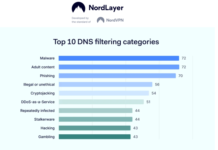
Our findings revealed Japan to be the most cyber-secure country in the world. It scored incredibly low across the majority of categories, only scoring a little higher in the preparation for cyber attacks and legislation categories.
Other top-performing countries included France, Canada, Denmark, and the United States.
As before, some countries scored well in one category but had other scores that brought their average up. These include Ukraine, which had the lowest financial malware rate, and Uzbekistan, Sri Lanka, and Algeria, which had the lowest telnet attack scores.
The lowest-scoring countries per category were:
- Lowest percentage of mobile malware infections – Japan – 1.34% of users
- Lowest number of financial malware attacks – Ukraine – 0.3% of users
- Lowest percent of computer malware infections – Denmark – 5.9% of users
- Lowest percentage of telnet attacks (by originating country) – Algeria, Uzbekistan, and Sri Lanka – 0.01%
- Lowest percentage of attacks by cryptominers – Denmark – 0.61% of users
- Best prepared for cyber attacks – Singapore – 0.925 score
- Most up-to-date legislation for cybersecurity – France, China, Russia, and Germany – all 7 categories covered
Overall cybersecurity rankings (from the worst to the best)
| Rank | Country | Score | Percentage of Mobiles Infected with Malware | Financial Malware Attacks (% of Users) | Percentage of Computers Infected with Malware | Percentage of Telnet Attacks by Originating Country (IoT) | Percentage of Attacks by Cryptominers | Best Prepared for Cyberattacks | Most Up-to-Date Legislation |
|---|---|---|---|---|---|---|---|---|---|
| 1 | Algeria | 55.75 | 22.88 | 0.9 | 32.41 | 0.01 | 5.14 | 0.432 | 1 |
| 2 | Indonesia | 54.89 | 25.02 | 1.8 | 24.7 | 1.51 | 8.8 | 0.424 | 4 |
| 3 | Vietnam | 52.44 | 9.62 | 1.2 | 21.5 | 1.73 | 8.96 | 0.245 | 2 |
| 4 | Tanzania | 51.00 | 28.03 | 0.7 | 14.7 | 0.04 | 7.51 | 0.317 | 1.5 |
| 5 | Uzbekistan | 50.50 | 10.35 | 0.5 | 21.3 | 0.01 | 14.23 | 0.277 | 3 |
| 6 | Bangladesh | 47.21 | 35.91 | 1.3 | 19.7 | 0.38 | 3.71 | 0.524 | 3.5 |
| 7 | Pakistan | 47.10 | 25.08 | 1.4 | 14.8 | 0.4 | 6.07 | 0.447 | 2.5 |
| 8 | Belarus | 45.09 | 9.33 | 0.7 | 31.1 | 0.04 | 9.73 | 0.592 | 3 |
| 9 | Iran | 43.29 | 28.07 | 0.8 | 12.7 | 1.71 | 4.51 | 0.494 | 2 |
| 10 | Ukraine | 42.58 | 10.85 | 0.3 | 28.7 | 1.17 | 7.6 | 0.501 | 3 |
| 11 | Nigeria | 42.54 | 28.54 | 0.7 | 15.6 | 0.89 | 4.54 | 0.569 | 2 |
| 12 | Peru | 41.25 | 13.81 | 0.9 | 16.6 | 0.22 | 6.29 | 0.374 | 3 |
| 13 | China | 40.80 | 25.61 | 1.4 | 11.8 | 27.15 | 1.73 | 0.624 | 7 |
| 14 | Sri Lanka | 39.59 | 13.71 | 1.1 | 18.8 | 0.01 | 3.61 | 0.419 | 3 |
| 15 | India | 39.30 | 25.25 | 0.7 | 21.8 | 2.59 | 4.4 | 0.683 | 3.5 |
| 16 | Greece | 39.06 | 5.78 | 2.3 | 21.6 | 0.73 | 1.77 | 0.475 | 4 |
| 17 | Romania | 39.02 | 6.42 | 1.2 | 24.6 | 0.61 | 3.21 | 0.585 | 2 |
| 18 | Ecuador | 38.29 | 14.13 | 0.7 | 16.8 | 0.4 | 3.73 | 0.466 | 2 |
| 19 | Azerbaijan | 38.20 | 6.53 | 0.9 | 26.7 | 0.03 | 7.13 | 0.559 | 4 |
| 20 | Egypt | 38.03 | 18.8 | 1.3 | 20.2 | 7.43 | 4.01 | 0.772 | 4 |
| 21 | Bulgaria | 37.86 | 7.96 | 0.4 | 21.5 | 10.57 | 2.74 | 0.593 | 4 |
| 22 | South Korea | 37.16 | 7.14 | 2.8 | 14.3 | 3.57 | 3.1 | 0.782 | 3 |
| 23 | United Arab Emirates | 36.88 | 9.14 | 1.9 | 20.7 | 0.09 | 2.99 | 0.566 | 4 |
| 24 | Philippines | 36.79 | 23.07 | 0.6 | 23.8 | 0.1 | 2.94 | 0.594 | 4 |
| 25 | Morocco | 36.47 | 10.61 | 1.5 | 21.7 | 0.11 | 3.01 | 0.541 | 4 |
| 26 | Slovakia | 35.57 | 5.32 | 0.6 | 22 | 0.13 | 2.76 | 0.362 | 3 |
| 27 | Tunisia | 35.54 | 9.85 | 1.2 | 21.5 | 0.1 | 2.78 | 0.591 | 3 |
| 28 | South Africa | 34.39 | 9.9 | 1 | 13.4 | 0.64 | 2.51 | 0.502 | 2 |
| 29 | Kenya | 34.16 | 21.43 | 1.2 | 17 | 0.15 | 3.39 | 0.574 | 5 |
| 30 | Brazil | 33.57 | 4.73 | 1.8 | 21.4 | 0.7 | 3.49 | 0.579 | 3 |
| 31 | Latvia | 33.05 | 6.25 | 1.4 | 23.1 | 0.17 | 4.17 | 0.688 | 4 |
| 32 | Saudi Arabia | 32.99 | 10.15 | 0.7 | 20.7 | 0.11 | 2.72 | 0.569 | 3 |
| 33 | Portugal | 32.79 | 5.25 | 1.9 | 20.9 | 0.09 | 1.63 | 0.508 | 5 |
| 34 | Thailand | 32.42 | 7.26 | 1 | 19.7 | 0.79 | 4.27 | 0.684 | 3 |
| 35 | Malaysia | 31.79 | 15.46 | 2.1 | 21.7 | 0.24 | 2.87 | 0.893 | 5 |
| 36 | Italy | 28.31 | 5.24 | 1.3 | 18 | 1.75 | 1.14 | 0.626 | 4 |
| 37 | Argentina | 28.11 | 11.71 | 0.9 | 18.8 | 0.86 | 2.11 | 0.482 | 6 |
| 38 | Russia | 28.02 | 10.11 | 0.6 | 23 | 7.87 | 6.89 | 0.788 | 7 |
| 39 | Colombia | 27.69 | 12.52 | 0.5 | 16.4 | 0.52 | 2.01 | 0.569 | 4 |
| 40 | Poland | 27.36 | 5.83 | 0.8 | 19.9 | 1.23 | 1.73 | 0.622 | 4 |
| 41 | Hungary | 27.30 | 7.28 | 0.8 | 20.2 | 0.3 | 4.19 | 0.534 | 6 |
| 42 | Mexico | 27.17 | 10.49 | 0.7 | 19.5 | 0.73 | 1.43 | 0.66 | 4 |
| 43 | Croatia | 27.09 | 3.66 | 1.8 | 15.2 | 0.05 | 1.91 | 0.59 | 5 |
| 44 | Germany | 26.48 | 3.41 | 3 | 15.7 | 1.11 | 0.91 | 0.679 | 7 |
| 45 | Austria | 25.76 | 2.94 | 1.4 | 12.3 | 0.12 | 0.84 | 0.639 | 3 |
| 46 | Spain | 24.12 | 5.14 | 0.8 | 18.6 | 1.1 | 1.56 | 0.718 | 4 |
| 47 | Turkey | 23.20 | 8.94 | 0.8 | 15.6 | 1.82 | 2.17 | 0.581 | 6 |
| 48 | Belgium | 21.03 | 4.11 | 0.4 | 13.5 | 0.07 | 0.97 | 0.671 | 3 |
| 49 | Czech Republic | 20.37 | 5.68 | 0.5 | 10.9 | 0.34 | 1.44 | 0.609 | 4 |
| 50 | Australia | 16.34 | 5.47 | 0.8 | 14.5 | 0.37 | 0.88 | 0.824 | 5 |
| 51 | Singapore | 15.13 | 8.18 | 0.8 | 8.5 | 0.14 | 1.61 | 0.925 | 4 |
| 52 | Netherlands | 15.00 | 3.71 | 0.6 | 8.1 | 0.32 | 1.06 | 0.76 | 4 |
| 53 | United Kingdom | 14.15 | 3.68 | 0.7 | 10.5 | 1.07 | 0.88 | 0.783 | 5 |
| 54 | Sweden | 13.78 | 3.15 | 0.4 | 11 | 0.45 | 1.31 | 0.733 | 5 |
| 55 | Ireland | 13.41 | 3.73 | 0.5 | 7.9 | 0.06 | 0.85 | 0.675 | 5 |
| 56 | United States | 12.20 | 7.68 | 0.5 | 10.3 | 4.47 | 0.71 | 0.919 | 5.5 |
| 57 | Denmark | 12.04 | 1.98 | 0.4 | 5.9 | 0.04 | 0.61 | 0.617 | 5 |
| 58 | Canada | 11.19 | 3.91 | 0.4 | 14.3 | 0.47 | 0.81 | 0.818 | 6 |
| 59 | France | 10.58 | 4.72 | 0.4 | 16.2 | 0.67 | 1.12 | 0.819 | 7 |
| 60 | Japan | 8.81 | 1.34 | 0.5 | 8.3 | 1.23 | 1.1 | 0.786 | 6 |
What can we take away from these findings?
Despite some countries having clear strengths and weaknesses, there is definite room for improvement in each and every one. Whether they need to strengthen their legislation or users need help putting better protections in place on their computers and mobiles, there’s still a long way to go to make our countries cyber secure.
Plus, as the landscape of cybersecurity constantly changes (cryptominers are growing in prevalence, for example), countries need to try and get one step ahead of cybercriminals.















